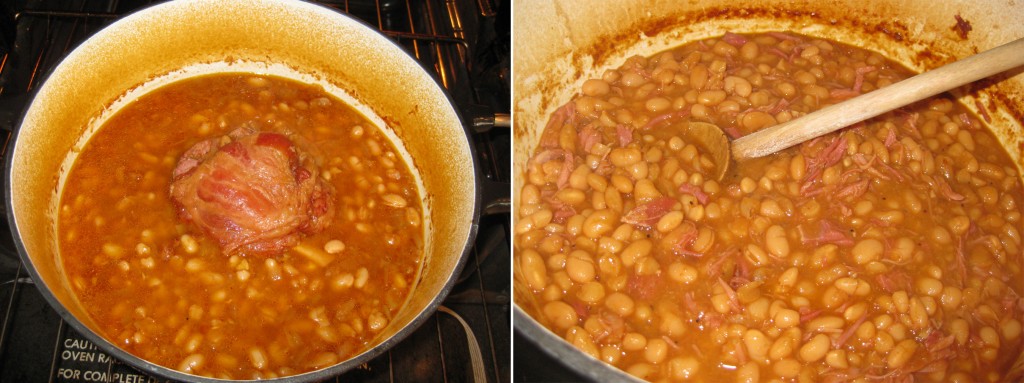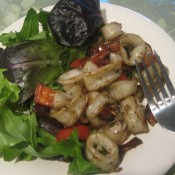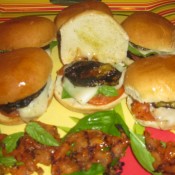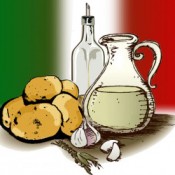
Hello everyone! It’s been a while since I’ve submitted a recipe to Cucina Domenico, but I thought that since Independence Day is this weekend, now would be a good time to share a great recipe for baked beans with you. I love it because it only requires one pot, it reheats wonderfully (actually, it’s even better the next day), it serves a crowd, and, if you’re not feeding a lot of people, it freezes well.
I found this recipe through Fine Cooking. I’m sure that by now you’ve noticed that Fine Cooking is one of my favorite sites for recipes. This is for a very good reason – their recipes almost always yield terrific results. This recipe in particular is one of them. I made one very minor change, but it made a huge impact on the flavor. The original recipe calls for salt pork, which is a saltier and usually much fattier version of bacon. Initially, I made it this way. It was very good, but not great. So I tried making it again using bacon instead. This time the results were much better, but still I felt it lacked something. Then I came across another recipe for baked beans which used a meaty smoked ham hock, so I decided to try it.
I’m still not sure what the difference between a ham hock and a ham shank is, but I purchased the latter one by accident. I use pork shanks to make soup all the time so I figured it would work. And it did, perfectly! Depending on the size I buy, I don’t always put all of the meat back in with the beans. Of course, none of it ever goes to waste. The leftovers make an awesome sandwich, ya know.
If, for some reason, you can’t find a ham hock or shank, do not hesitate to make this using the bacon. Don’t get me wrong, we ate the first two batches of baked beans without complaints. Both were better than anything you can buy in a can, but the third version is the cream of the crop. It is very meaty, and it has a wonderful smoky flavor.
Here’s a few tips:
First, don’t salt this dish (or any dish that has uncooked beans in it for that matter) until the beans are completely cooked. Adding salt before the beans are cooked can cause the beans to become tough or not cook through properly. Some people will dispute this, but, in my experience, I say not to. I’ve chosen to ignore this advice a few times and each time I regretted it.
Second, as I mentioned earlier, this is much better the next day. The flavors really come together and once it cools, it thickens nicely. That doesn’t keep me from making this the day I plan on serving it though. Oftentimes, I’ll just make it in the morning and let it cool on the stove until we are ready to eat. By then, the beans usually have a nice consistency, and no one ever complains about lack of flavor.
Boston Baked Beans
Adapted from Fine Cooking
Ingredients
1 lb. navy beans, yellow-eye beans, or other dried white beans (I use great northern beans, and the cooking time is approximately 2 1/2 to 3 hours. The cooking time will vary depending on the size of your bean.)
1 meaty smoked ham hock, ham shank, or 4 oz. of bacon or salt pork (rind removed and reserved)
1 chopped medium onion (5 to 6 oz.), cut into 1/2-inch dice
1 tsp. finely chopped garlic (optional)
4 to 5 cups water; more as needed
2 Tbs. dark molasses (but not blackstrap)
2 Tbs. maple syrup
3 Tbs. Heinz chili sauce or tomato ketchup (I always use ketchup)
2 Tbs. Dijon mustard
1 Tbs. Worcestershire sauce
Freshly ground black pepper to taste
1 tsp. kosher salt; more to taste
1 Tbs. apple-cider vinegar
Directions
Pick over beans and soak them in water overnight. The next morning, discard any beans that are floating on the surface, and drain the beans.
Heat oven to 350 degrees F.
Heat a large 5-qt Dutch oven. If using the ham hock or shank, add about 1-2 tbs extra virgin olive oil to the pan, and add the onion and garlic and cook until it begins to soften, about 5 minutes. If using the salt pork or bacon, omit the olive oil, add the salt pork or bacon to the pot, and cook until crisp and golden, about 10 minutes. At this point you should have enough fat to cook your onions and garlic in.
Add 4 cups of the water, the molasses, maple syrup, chili sauce or ketchup, mustard, Worcestershire sauce, and pepper. Stir well to combine. Increase the heat to high and bring to a boil. Add the drained beans and the reserved pork rind, ham hock, or ham shank (if using) and wait for the boil to return. Cover the pot and transfer it to the oven.
After the beans have been in the oven for 10 minutes, turn the heat down to 300°F. After 1 hour, check the pot and add water as needed to keep the beans just barely covered. Also, if using a ham shank, turn about every half hour to be sure it cooks evenly. Check it again every half hour. You may need to add up to 1 cup for navy beans and 1-1/2 cups water for yellow-eye beans, but be wary of making them too watery, especially near the end of cooking. If the ham shank or hock starts to fall off the bone before the beans are finished, carefully remove it from the pot with tongs and place it on a cutting board to cool. Once cool, shred the pork with your fingers and add the meat back to the pot with the beans.
The beans are ready when they’re very soft and tender yet still retain their shape, about 2 to 2-1/2 hours for navy beans; 3-1/2 hours for yellow-eye beans. Remove the beans from the oven and discard the pork rind (if using) or the ham shank or hock if you haven’t done so earlier and proceed as described above. Add the vinegar and season the beans with salt and more pepper, if you like. Stir the beans gently; as you stir, the starches will be released and the baked beans will become lightly thickened. Don’t over mix when they’re this hot. Let them sit for at least 20 minutes before serving. They can also be cooled completely, refrigerated, and then gently reheated.








Recent Comments